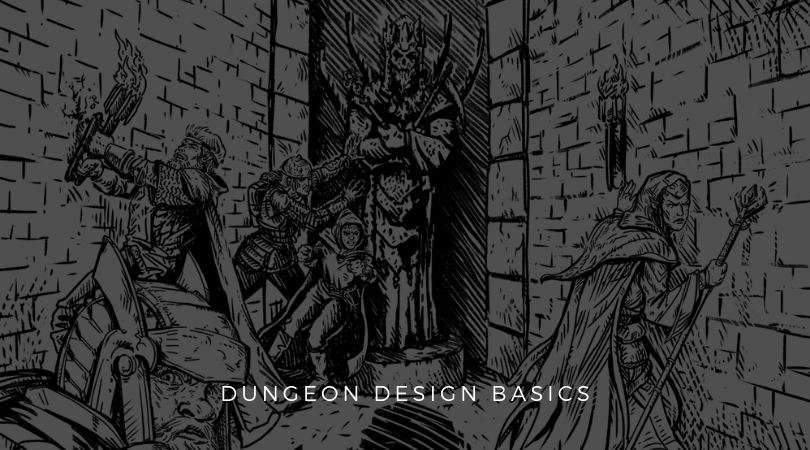Dungeon Design Basics

Dungeons that are nothing but a series of rooms containing a random assortment of monsters and treasures, with no real reason for existing embody sloppy, lazy design.
To create memorable dungeons, you must consider much more than simply what to stick in its rooms. The mechanics of your prefered game obviously play a huge part in designing an enjoyable dungeon. However, beyond mechanics, you should also consider the following factors when designing a dungeon:
Original Purpose of the Dungeon
A dungeon designed as a gigantic tomb will look and feel entirely different to one that was once a grand temple. In either case, the layout will feature different kinds of rooms, chambers and corridors based on what the original builders needed the dungeon to do. The dungeon's architectural feature's decoration, and layout will also be different.
For example:
- An orc tribal lair now occupied by kobolds will have higher ceilings than a normal kobold warren.
- An ancient tomb will probably feature altars, burial niches, stone sepulchres and the like.
- An old temple will feature processional corridors, large areas set aside for worship and (probably) crypts.
Who Built the Dungeon
A dungeon’s builder inevitably leaves their mark on the structure. They may leave grandiose statues of themselves or other important personages, certain room features or decorations or other evidence of their influence. Perceptive characters will likely detect even a long-dead builder’s influence on the dungeon.
For example:
- A dwarf built dungeon will feature stone doors, low ceilings and cunning hidden secret doors.
- A human built dungeon may feature higher ceilings, light wells and decorates depicting the surface world.
- A dungeon built by drow will likely feature many carvings of spiders and the like.
History of the Dungeon
A dungeon’s history inevitably affects its disposition. A dungeon’s age also affects the conditions of many of its features. Wooden doors rot, flagstones shift, metal portcullises rust and so on.
For example:
- A dungeon struck by an earthquake will likely exhibit extensive damage.
- A dungeon that periodically floors will have signs of such a disaster. Water staining, piles of debris at the high tide line and so on may provide valuable clues to the potential danger.
- A dungeon that has remained sealed for centuries will have many archaic features. Dust may also lie thickly on the floor, and the air will likely be stale.
Current Purpose of the Dungeon
Even if the dungeon was conceived as the tomb of a powerful mage, the orc tribe now lurking within will adapt and change it to suit their needs. Attentive characters will likely detect features added during both phases of its use.
For example:
- A dungeon used as a tribal lair or bandit hideout will likely have some elements of fortification at the entrance.
- A dungeon claimed by hobgoblins will have much better-organised defences than one claimed by orcs.
- A dungeon that has become a shrine to an evil power will feature torture chambers, cells, bloody altars and so on.
Dungeon Inhabitants
The dungeon’s past and present inhabitants leave their mark on the dungeon. They may have altered the original structure, decorated it in distinctive fashions and so on. Some monsters may also have distinctive smells or make certain sounds that betray their presence.
For example:
- A dungeon infested with orcs will likely be noisy. dirty and smelly.
- A dungeon home to a gelatinous cube will have suspiciously clean floors.
- A dungeon that was once a temple will likely feature altars, statues and religious decorations which may, or may not, be vandalised by the current inhabitants.
Fame of the Dungeon
Some dungeons become famous (or infamous) for the dangers lurking within, or the treasures said to lie in their depths. Such locations attract more than their fair share of adventurers. Nearby settlements may even spring up nearby to service the many adventurers trying their luck in the dungeon.
For example,
- A dungeon known to be the final resting place of a powerful lich or vampire may have a well-staffed temple of good nearby.
- A dungeon known to produce much wealth will likely have a settlement with many traders dealing in luxury items of interest to adventurers.
- A dungeon lying at the bottom of an extensive cave system may have a settlement nearby where the characters can hire guides, porters and the like.
Upcoming Events
Upcoming events can affect the dungeon.
For example:
- A dungeon "hosting" a battle of annihilation between duergar and troglodytes will have many signs of the conflict. Areas will be battle-damaged, corpses may lie strewn about, some areas will be trapped or fortified and so on.
- A dungeon at the centre of an evil mastermind's planning to subjugate the surrounding countryside will have many different features. Undoubtedly, many troops will be billeted in and around the dungeon, some areas will be given over to industry (weaponsmiths, blacksmiths and the like) or used as storerooms holding the supplies required to sustain the army.
- A dungeon said to be the birthplace of a great evil may be a site of pilgrimage for foul cultists or a place holy clerics and paladins watch over.
Did I Miss Something?
Did I miss something fundamental to basic dungeon design? Let me know by signing up for a full Gameatory account and joining our exclusive Slack channel.

Member discussion